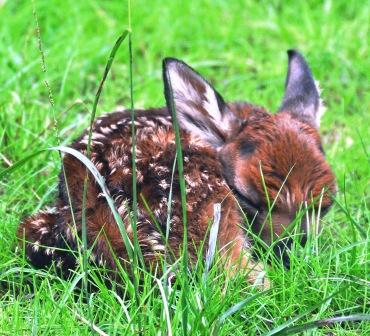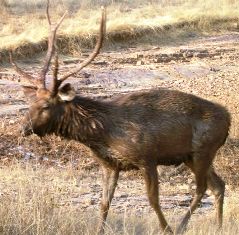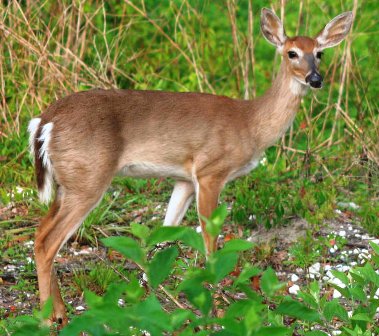Discover Florida Nature
It's time to explore the natural Florida


|
|
|
|
|
 Key
Deer-The Florida Key deer is one of the smallest of all 30
subspecies of white-tailed deer. The Key deer is a subspecies of the
white-tailed deer and is only found in the keys of southern Florida. The
key deer, an endangered
species in the state of Florida, is similar in appearance to
white-tailed deer, but smaller and with proportionally shorter legs. It
also has a black mask on its face. The Key deer is the smallest of all
white-tailed deer. Bucks range from 28-32 inches at the shoulder and
weigh an average of 80 pounds, while does stand 24-28" at the shoulder
and weigh an average of 65 pounds. Key deer use all habitat types within
their range, including pine rocklands,
hardwood hammocks,
mangroves, and
freshwater wetlands.
Pine rocklands are
of particular importance because they contain permanent freshwater
sources, which are essential for their survival. Key deer feed on over
160 species of plants including the native red, black and white
mangroves and thatch palm berries. As human development has increased
within the range of the Key deer they have increased their use of
residential and commercial areas where they feed on ornamental plants.
Breeding season is from September through December. Typically, a single
fawn is born. Free-ranging dogs, along with vehicles, are a primary
cause of mortality for Key deer. Key
Deer-The Florida Key deer is one of the smallest of all 30
subspecies of white-tailed deer. The Key deer is a subspecies of the
white-tailed deer and is only found in the keys of southern Florida. The
key deer, an endangered
species in the state of Florida, is similar in appearance to
white-tailed deer, but smaller and with proportionally shorter legs. It
also has a black mask on its face. The Key deer is the smallest of all
white-tailed deer. Bucks range from 28-32 inches at the shoulder and
weigh an average of 80 pounds, while does stand 24-28" at the shoulder
and weigh an average of 65 pounds. Key deer use all habitat types within
their range, including pine rocklands,
hardwood hammocks,
mangroves, and
freshwater wetlands.
Pine rocklands are
of particular importance because they contain permanent freshwater
sources, which are essential for their survival. Key deer feed on over
160 species of plants including the native red, black and white
mangroves and thatch palm berries. As human development has increased
within the range of the Key deer they have increased their use of
residential and commercial areas where they feed on ornamental plants.
Breeding season is from September through December. Typically, a single
fawn is born. Free-ranging dogs, along with vehicles, are a primary
cause of mortality for Key deer.
 Sambar
Deer-
The Sambar Deer is an introduced species found in wetlands on St.
Vincent Island in Franklin County, Florida. Originally from Asia, the
Sambar deer was introduced onto St. Vincent Island in 1908. Deer have
thrived on the island, and occasional escapees have caused no serious
problems. Regulated hunting is used to control the population. It is
much larger than the native white-tailed deer and is one of the larger
members of the deer family. Sambar deer can reaching a length of 78-102
inches. It is dark brown in the winter and chestnut during the summer
months, with a large muzzle and broad ears. Males are antlered, and
antlers can grow as large as 38 inches. The diet of the Sambar deer
consists mainly of aquatic plants. These deer have a life expectancy of
16-20 years. Sambar
Deer-
The Sambar Deer is an introduced species found in wetlands on St.
Vincent Island in Franklin County, Florida. Originally from Asia, the
Sambar deer was introduced onto St. Vincent Island in 1908. Deer have
thrived on the island, and occasional escapees have caused no serious
problems. Regulated hunting is used to control the population. It is
much larger than the native white-tailed deer and is one of the larger
members of the deer family. Sambar deer can reaching a length of 78-102
inches. It is dark brown in the winter and chestnut during the summer
months, with a large muzzle and broad ears. Males are antlered, and
antlers can grow as large as 38 inches. The diet of the Sambar deer
consists mainly of aquatic plants. These deer have a life expectancy of
16-20 years.  White
Tailed Deer- White tailed deer are found in forest edge
habitats through out the state of Florida. This deer is gray to russet
brown with a white underside. It is large, 55-80 inches, with large
ears, a large tail, and long slender legs. Male white tailed deer have
antlers. Antlers are largest on males 6-10 years old. They are shed in
late winter or early spring and re-grow 6-8 weeks later. White
Tailed Deer- White tailed deer are found in forest edge
habitats through out the state of Florida. This deer is gray to russet
brown with a white underside. It is large, 55-80 inches, with large
ears, a large tail, and long slender legs. Male white tailed deer have
antlers. Antlers are largest on males 6-10 years old. They are shed in
late winter or early spring and re-grow 6-8 weeks later. White tailed deer are herbivore, feeding primarily on twigs and leaves. Its diet also includes acorns, fruits, and mushrooms. Plants attractive to deer include cross vines, Hercules club, persimmons, sourwood, redbud, buttonbush, ash, tupelo and gum trees, and beautyberry. Most browsing is done at night or on overcast days. Although deer have several different calls, compared to smell and visual cues, vocalizations play a relatively minor role in deer communication. Sounds that are important include bleating or "mewing" by fawns which are used to summon their does. Breeding season is from September to March. About 200 days later, a litter of 1-3 fawns is born. The young begin accompanying the mother to feed at 3-4 weeks but are not weaned for another 2-3 months and will remain with her until they are 6-18 months old. Many deer suffer injury and even death from collisions with automobiles, entanglements in fences, drowning, and other miscellaneous accidents. Other potential causes of injury and poor health are poisonous plants, heavy metals, and pesticides. Mercury and chromium have been found in live Florida deer but sub-lethal effects are not known. Pesticide residues are known to increase postpartum mortality, slow down development of immature deer, and impair initial conception by young does. White-tailed deer are hosts to many parasites and infectious agents. Biologists have documented 120 different parasites, infections, and disease conditions of Florida deer. Many of these, by themselves, will not cause sickness or death. However, they can cause harm if other factors such as stress and malnutrition weaken an animal's resistance to infection. A few mammalian predators prey on deer in Florida. Whitetails are the second most common prey next to wild hogs for panthers. Bobcats are another important predator. Coyotes have become more plentiful in Florida during the past decade and likely prey on Florida deer. Black bear occasionally take newborn fawns. |
|
|
Advertise | Privacy Statement | Contact | Alaska Nature | Michael Arnold Art| Dog Encyclopedia | Dog Encyclopedia| |
|